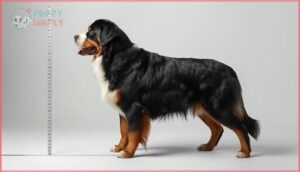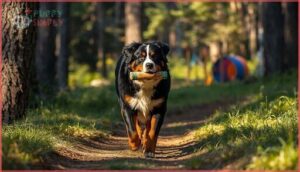This site is supported by our readers. We may earn a commission, at no cost to you, if you purchase through links.

Today, they’ve become beloved family members known for their patient temperament and unwavering loyalty. But their impressive size and thick double coat come with specific care requirements that every potential owner should understand.
If you’re considering bringing one of these majestic dogs into your home, you’ll want to know what makes them tick—from their exercise needs to the health concerns that unfortunately come with the breed.
Table Of Contents
Key Takeaways
- Bernese Mountain Dogs typically live only 6 to 8 years, with over 50% dying from cancer like histiocytic sarcoma, making their lifespan significantly shorter than most breeds.
- These gentle giants need 1 to 1.5 hours of daily exercise and consistent grooming—expect heavy shedding twice yearly and brushing sessions 2 to 3 times weekly to manage their thick double coat.
- Their patient, loyal temperament makes them excellent family dogs with minimal aggression (only 3% aggression score), though they require early socialization between 7 and 16 weeks for best results.
- Hip and elbow dysplasia affect about 15% of the breed, and bloat poses a serious risk, so you’ll need to split their 1,400 to 2,000 daily calories into two meals and avoid exercise right after eating.
Bernese Mountain Dog Breed Overview
The Bernese Mountain Dog isn’t just another pretty face with that stunning tri-colored coat. This breed carries centuries of Swiss heritage as a working farm dog, and understanding where they came from helps you appreciate what makes them tick today.
Let’s walk through their background and what role these gentle giants play in modern homes.
Origin and History
Roman Roots reach back over 2,000 years—your Bernese Mountain Dog descends from mastiffs Roman soldiers brought to Switzerland. This Swiss Heritage began in Bern’s valleys, where these Alpine History champions became essential farm dogs.
By 1907, Swiss breeders formalized this Ancient Breed’s standard, transforming working “Cheese Dogs” into the beloved Swiss Mountain Dog you know today. That’s the Bernese Mountain Dog Origin story. The breed’s original purpose was for general farm work, which included various tasks.
Popularity and Uses
From their Swiss roots, Bernese Mountain Dogs have become the 19th most popular breed in America’s 2024 rankings. You’ll find them thriving as Family Pets in 10 US states, particularly in colder regions. Their Working Group classification reflects their versatility—these Family dogs excel in Therapy Work, search-and-rescue, and carting competitions.
Dog breed popularity for Berners continues rising globally, especially where Working Roles meet companion needs. The popularity of breeds like the Bernese Mountain Dog can be found in the dog breed rankings.
Physical Characteristics and Appearance
Bernese Mountain Dogs are built for work and cold weather, with a strong frame that draws the eye. Their distinctive tri-colored coat and gentle expression make them instantly recognizable.
Let’s look at what makes their physical appearance so striking.
Size and Weight
If you’re considering a Bernese Mountain Dog, understanding their size helps with weight management and space planning. Males usually reach 80 to 115 pounds and stand 25 to 27.5 inches at the withers, while females weigh 70 to 95 pounds and measure 23 to 26 inches tall.
Growth patterns show most Berners reach full height by one year but continue filling out until age three. Body proportions remain slightly longer than tall.
Coat Type and Colors
Your Bernese Mountain Dog’s double coat is more than just beautiful—it’s built for mountain life. The thick undercoat insulates, while the outer layer repels moisture. The tricolor pattern follows strict genetics: jet black base, rich rust markings above the eyes and on the chest, plus white accents.
Here’s what makes their coat special:
- Shedding happens twice yearly over 3–6 weeks
- Brush at least three times weekly
- Coat texture ranges from straight to slightly wavy
- Color genetics guarantee consistent black-rust-white patterns
Unique Markings and Features
The breed’s tricolor pattern isn’t random—it follows precise standards. Over 95% of Bernese Mountain Dogs display the classic black base with rust markings above the eyes, on cheeks, chest, and legs. White appears on the face, chest, paws, and tail tip.
You’ll often spot a “Swiss kiss”—that prized white patch at the neck’s base—in about 60% of dogs. Symmetry matters in show rings.
Temperament and Personality Traits
Bernese Mountain Dogs are known for their gentle, even-tempered nature, making them wonderful companions for the right household. These dogs form strong bonds with their families and generally get along well with children and other pets when properly socialized.
Let’s look at the key personality traits you can expect from this breed.
Family Friendliness
If you’re searching for a gentle nature and rock-solid family bonds, you’ll find them here. Bernese Mountain Dogs earn their reputation as “nanny dogs” with an aggression score of just 3.0%, making them exceptionally kid-friendly.
Their household dynamics thrive on loyalty—80% form deep attachments with children—while their patience during boisterous play makes them an ideal family pet for homes seeking a good with children companion.
Interaction With Other Pets
Your Bernese Mountain Dog’s gentle temperament extends beautifully to multi-pet households, with 90% of owners reporting positive canine harmony. Pet socialization early in life matters most, though:
- Puppyhood introductions (3–16 weeks) yield the highest success for interspecies bonding with cats and dogs.
- Supervised meet-and-greets over several weeks promote smooth household dynamics.
- Separate feeding stations prevent resource guarding in pet-friendly homes.
Adult Berners adapt well with patience and positive reinforcement training.
Watchdog and Protective Nature
Your Bernese Mountain Dog’s watchdog instincts stem from centuries of guarding Swiss farms. Approximately 91% exhibit natural protective tendencies, relying on strategic positioning and deep barking rather than aggression. They’re medium barkers—85% alert you to strangers or unusual sounds—but excessive noise is rare.
| Protective Behavior | Occurrence Rate |
|---|---|
| Alert barking at visitors | 85% of owners report |
| Proximity protection (staying close) | 91% natural tendency |
| Unprovoked aggression | Only 4% documented |
| Peaceful interventions | 73% act as peacekeepers |
| Child safeguarding positioning | 88% gravitate to vulnerable family |
Their threat response involves vocal deterrents and body blocking, not biting. This guard dog breed provides reliable alert systems while maintaining a calm, family-friendly defensive behavior.
Energy Level and Playfulness
Think of your Berner as a workhorse with a playful heart—they show moderate energy that needs both physical outlets and mental challenges. Daily activity requirements stay manageable yet essential for their wellbeing.
Your dog’s exercise needs include:
- 60 to 120 minutes of daily activity split across morning walks, evening outings, and afternoon play sessions
- Age-adjusted routines—puppies need shorter bursts while seniors prefer gentle, joint-friendly movement
- Mental stimulation through puzzle toys and interactive games that tap into their herding heritage
Playfulness peaks in youth, then mellows into calm companionship. Their energy patterns reflect Swiss working origins—bursts of enthusiasm followed by contented rest. Hot weather dampens their playful behavior due to that thick coat, so adjust exercise intensity accordingly. Without adequate dog exercise, you’ll notice restlessness or unwanted behaviors emerging.
Health and Care Requirements
Keeping your Bernese Mountain Dog healthy means understanding what this breed needs from day one. These gentle giants face some specific health challenges that you should know about before bringing one home.
Let’s walk through the essentials—from common medical concerns to the daily care that keeps your Berner thriving.
Common Health Issues
Your Berner faces some serious health challenges you need to know about. Cancer risks top the list, with over 50% of these dogs dying from malignancies like histiocytic sarcoma.
Berners face serious health risks, with over half dying from cancer like histiocytic sarcoma
Hip dysplasia and elbow dysplasia affect roughly 15% of the breed, while degenerative myelopathy causes progressive paralysis.
Gastrointestinal issues like bloat require immediate attention, and eye disorders including progressive retinal atrophy can lead to blindness.
Lifespan Expectations
Unfortunately, your Bernese Mountain Dog’s lifespan falls shorter than most breeds—usually 6 to 8 years, though some reach 10. Females outlive males by about a year.
Cancer research shows mortality rates exceed 58%, with genetic factors playing a significant role.
Recent health interventions and longevity trends indicate modest improvements, with Swiss studies documenting median life spans reaching 8.4 years in well-monitored populations.
Diet and Nutrition
Proper nutrition helps counteract some health challenges your Bernese Mountain Dog faces. Adult Berners need 1,400 to 2,000 calories daily, split between two meals to reduce bloat risk. Puppies require more frequent feeding—three to four times daily—with higher caloric intake during growth spurts.
Key nutritional considerations for your Bernese Mountain Dog diet and nutrition:
- Protein levels: Puppy food should contain 22–28% protein; adults need 18–24%
- Calcium balance: Maintain proper ratios (1.2:1 to 1.4:1) to support joint health
- Meal frequency: Feed adults twice daily, spacing meals 12 hours apart
- Dietary supplements: Add glucosamine and omega-3s after age two
- Food allergies: Watch for chicken sensitivities, affecting 13–15% of the breed
Portion sizes usually range from 3 to 6 cups of dry food daily, adjusted for your dog’s activity level and weight. Slow feeder bowls help prevent rapid eating and gastric issues.
Grooming and Shedding Needs
Your Bernese Mountain Dog’s double coat demands consistent attention throughout the year. Expect moderate shedding daily, with intense coat blows twice annually lasting 3–6 weeks each. During shedding season, daily brushing with slicker brushes and undercoat rakes prevents matting behind ears and legs. Professional grooming every 6–8 weeks costs $75–$160, though you can supplement with home brushing sessions.
| Grooming Task | Frequency |
|---|---|
| Brushing (normal periods) | 2–3 times weekly |
| Brushing (shedding season) | Daily |
| Professional grooming | Every 6–8 weeks |
Training and Exercise Needs
Training a Bernese Mountain Dog requires consistency and patience, but their intelligence makes the process rewarding. These gentle giants need regular physical activity to stay healthy, along with mental challenges to keep their sharp minds engaged.
Let’s look at what you’ll need to know about training methods, socialization, exercise requirements, and ways to keep your Berner mentally stimulated.
Trainability and Intelligence
You’ll find that Bernese Mountain Dogs rank impressively—27th out of 140+ breeds in intelligence rankings. They’re quick learners, mastering new commands in just 5–15 repetitions.
Their adaptive intelligence shines through problem-solving tasks, and they excel in obedience training with positive reinforcement.
Mental stimulation through activities like carting enhances their trainability. Consistent, routine-based sessions work best for this sensitive, eager-to-please breed.
Socialization Tips
To set your Bernese Mountain Dog puppy up for success, start early socialization between 7 and 16 weeks—the critical window when positive exposure yields the best outcomes.
Gradually introduce your pup to diverse environments, people, and vaccinated dogs using positive reinforcement like treats.
Avoid overwhelming encounters or forced interactions, as these pitfalls can increase fear responses by 17-22% and undermine your socialization training efforts.
Exercise Routines
Your adult Bernese Mountain Dog needs 1 to 1.5 hours of daily exercise, split into morning and evening walks of 30–45 minutes each, plus interactive play sessions.
Puppy exercise should follow the five-minute rule per month of age—limiting a six-month-old to 30-minute sessions to protect developing joints.
Senior dogs benefit from gentler 20–30 minute walks.
Avoid exercise immediately after meals to prevent bloat.
Mental Stimulation Activities
How do you keep that sharp mind engaged? Mental stimulation is essential for your Bernese Mountain Dog’s well-being. Puzzle toys and scent games tap into their natural problem-solving abilities, while training games reinforce obedience and build confidence.
Food challenges like treat-dispensing toys extend mealtime and provide cognitive exercise.
Don’t forget social play—interactive activities combining physical and mental elements reduce boredom behaviors by over 50%.
Frequently Asked Questions (FAQs)
What are the adoption costs for this breed?
Adopting a Bernese Mountain Dog from rescues generally costs $500 to $1,200, with puppies priced higher. Shelter variance exists, ranging from $350 to $1,
Adoption benefits include wellness exams, vaccinations, and age discounts for older dogs.
Do they drool excessively compared to other breeds?
Bernese Mountain Dogs drool moderately—less than Saint Bernards or Mastiffs but more than dry-mouthed breeds. Their relatively tight jowls and breed standard minimize excessive drooling, though individual variation exists based on excitement or health factors.
Are Bernese Mountain Dogs good for apartment living?
You can keep them in apartments, but it’s challenging. Their exercise needs, mental stimulation requirements, and heavy shedding demand serious owner commitment.
Space considerations and noise management make adaptability difficult without consistent effort.
How do they handle being left alone daily?
Large, loyal breeds like these struggle considerably with separation anxiety—approximately 14-20% show distress behaviors.
Daily exercise routines, environmental enrichment, and gradual confinement methods help your Bernese Mountain Dog temperament adjust to alone time better.
Conclusion
Perhaps it’s no accident that the Bernese Mountain Dog thrives when given a job—whether that’s pulling a cart or simply watching over your family. These gentle giants need your commitment to their health, grooming, and exercise routines.
If you’re prepared to manage their specific care requirements and accept their shorter lifespan, you’ll gain a loyal companion whose patient temperament and unwavering devotion make every moment together worthwhile. They deserve nothing less than your best effort.
- https://k9carts.com/blogs/resources/bernese-mountain-dog-lifespan
- https://wopet.com/dogs/bernese-mountain-dog-health-issues/
- https://www.webmd.com/pets/dogs/what-to-know-about-bernese-mountain-dogs
- https://www.petmd.com/dog/breeds/bernese-mountain-dog
- https://www.borrowmydoggy.com/doggypedia/dog-breed-guides-bernese-mountain-dog












